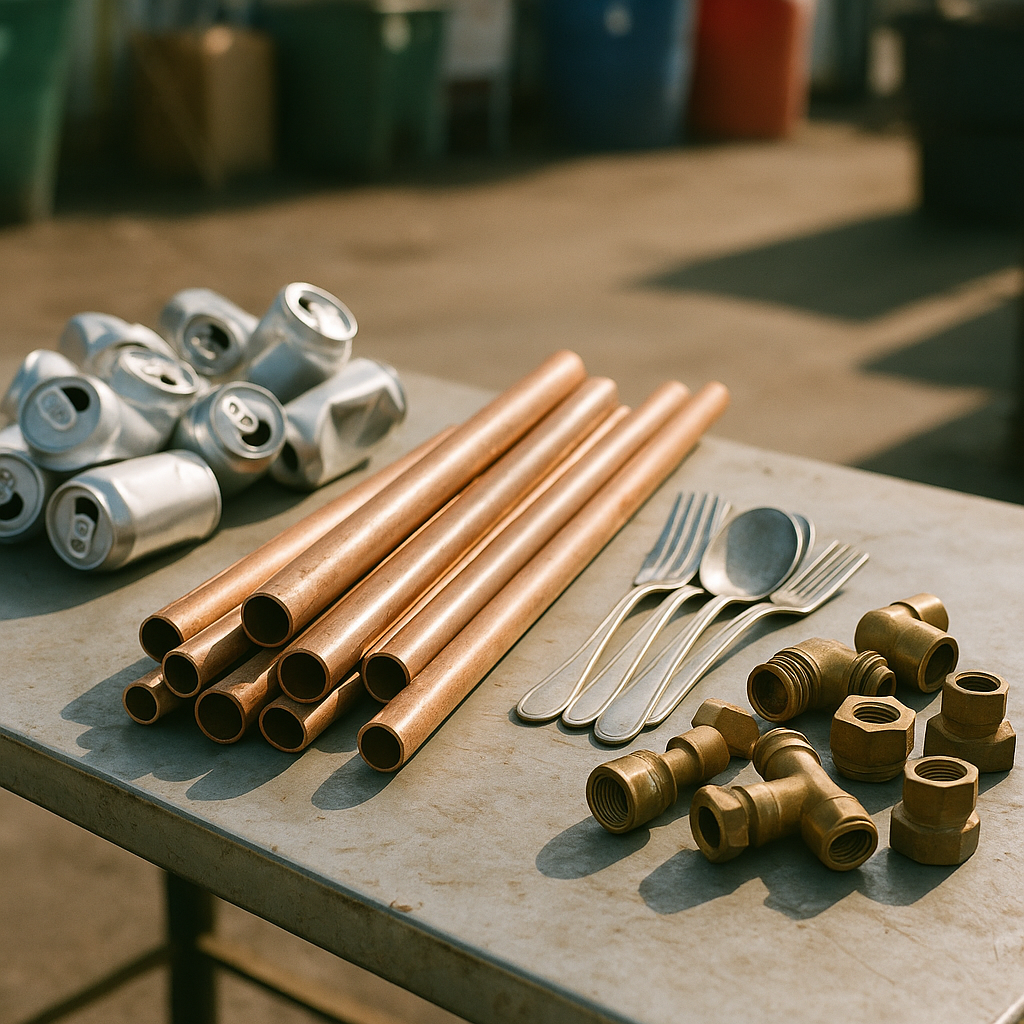5901 Botham Jean Blvd, Dallas, TX 75215
Recycling Metal Items: Types, Preparation Tips, and Key Benefits
August 29, 2025Did you know that the metal items you use every day can have a second life? Almost all metals can be recycled repeatedly without losing their quality or properties. This makes metal recycling an efficient form of resource conservation.
Your kitchen alone contains numerous recyclable metals. Aluminum cans, tin cans, steel food containers, metal bottle caps, and aluminum foil can all be recycled. Even empty aerosol cans and clean paint cans belong in your recycling bin rather than the trash.
Beyond household items, larger metal objects have significant value in the recycling stream. Old appliances like refrigerators and washing machines, vehicles reaching the end of their useful life, and construction materials such as rebar and steel beams can be transformed into new products. The metal recycling industry thrives on these materials, reducing the need for environmentally costly mining operations while conserving energy and natural resources.
What Are the Different Types of Recyclable Metals?

Metal recycling is divided into two main categories: ferrous and non-ferrous metals. These classifications help recycling facilities process materials efficiently and ensure proper resource recovery. Each type has distinct properties that influence its recycling value and applications.
Ferrous Metals
Ferrous metals contain iron as their primary component. They are easily identifiable using a simple magnet test—if a magnet sticks, it’s ferrous. Valued for their strength and durability, these metals are generally less valuable by weight compared to non-ferrous metals.
Common examples of recyclable ferrous metals include:
- Steel—Found in construction materials, appliances, and shipping containers
- Cast Iron—Used in cookware, pipes, radiators, and older bathtubs
- Carbon Steel—Present in automotive components, furniture, and structural elements
When exposed to moisture, ferrous metals tend to rust due to their high carbon content. Despite this, they remain highly recyclable. The recycling process involves melting, purifying, and compacting these metals into solid blocks for reuse in manufacturing.
Non-Ferrous Metals
Non-ferrous metals contain little or no iron. They do not attract a magnet, making it easy to identify them. These metals are typically more valuable at recycling centers and priced per pound, unlike ferrous metals, which are priced by the ton.
Common examples of recyclable non-ferrous metals include:
- Aluminum—Used in beverage cans, window frames, siding, and vehicle parts
- Copper—Found in electrical wiring, plumbing fixtures, and electronics
- Brass—Present in plumbing valves, doorknobs, and musical instruments
- Bronze—Used in fixtures, tools, and decorative items
- Lead—Found in batteries, cables, and radiation shielding
Non-ferrous metals offer better resistance to corrosion than ferrous metals, making them ideal for applications exposed to moisture and weather elements. Aluminum recycling is particularly efficient, requiring only 5% of the energy needed to produce new aluminum.
Recycling Value and Process
The recycling value of metals varies significantly between ferrous and non-ferrous types. The latter generally commands higher prices due to scarcity and demand, though both categories provide substantial environmental benefits when recycled.
The metal recycling process typically involves:
- Collection and sorting of metals by type
- Processing through shredding or compacting
- Melting in furnaces at appropriate temperatures
- Purification to remove contaminants
- Formation into new products or materials
Both ferrous and non-ferrous metals can be recycled repeatedly without degrading in quality or strength. This makes metal recycling one of the most efficient forms of resource recovery.
Understanding the differences between these metal types helps consumers properly sort recyclables, ensuring these valuable materials return to manufacturing rather than ending up in landfills.
How Should Metal Items Be Prepared for Recycling?

Properly preparing metal items before recycling enhances the quality of recycled materials and maximizes their value. A few simple steps can significantly improve the recycling process’s effectiveness.
First, clean all metal containers to remove food residue. Rinse cans, aluminum trays, and other food containers thoroughly to clear any remaining contents. This prevents contamination and minimizes odors in storage. While scrubbing them spotless isn’t necessary, a quick rinse is crucial for quality recycling.
For small metal items like bottle caps, paper clips, or small hardware, collect them in a larger metal can. Once full, pinch the top closed to keep these smaller items contained, preventing them from falling through sorting equipment at recycling facilities.
Remove non-metal components when possible. If a metal item has plastic handles, rubber gaskets, or wooden elements, separate these parts before recycling. Pure metal has greater value and requires less processing.
When dealing with metal items containing hazardous materials, inform your recycling center beforehand. Some metals might have been in contact with chemicals or harmful substances requiring special handling.
For electronics and appliances containing metal, check with local recycling centers for proper disposal methods. Many electronics contain valuable metals like copper and aluminum but may also include hazardous materials needing specialized processing. These items often cannot be included in curbside recycling and require drop-off at designated collection points.
Larger metal items, such as appliances, metal furniture, or automotive parts, typically need to be taken directly to scrapyards instead of placed in curbside recycling bins. Scrapyards are equipped to handle and process bulky metal objects efficiently.
When transporting scrap metal to recycling facilities, use sturdy containers to prevent injuries from sharp edges. Separate ferrous (magnetic) from non-ferrous (non-magnetic) metals using a magnet to streamline the recycling process and potentially increase the value of your materials.
Remember, different metals have varying values in the recycling market. Copper, brass, and aluminum usually fetch higher prices than steel or iron. Properly sorting your metals can lead to better environmental outcomes and potentially higher returns if you’re selling scrap metal.
Following these preparation steps ensures metal items are efficiently recycled into new products, conserving natural resources and reducing the environmental impact of metal production.
What Are the Benefits of Recycling Metal Items?

Metal recycling is a powerful method to protect our environment and support economic growth. The benefits extend beyond reducing landfill waste. Recycling metal creates a ripple effect of positive outcomes that impact our society and planet.
Environmental Benefits
Metal recycling offers significant environmental advantages. By recycling metals rather than mining for new materials, we substantially lower our carbon footprint. Mining leads to deforestation, soil erosion, and water pollution, while also releasing greenhouse gases.
Recycling metals significantly reduces energy consumption compared to producing new metals from raw materials. For aluminum, the energy savings are especially notable – recycling aluminum uses 95% less energy than creating it from bauxite ore. These energy savings lead directly to reduced carbon emissions.
Steel recycling also makes a substantial impact, reducing CO2 emissions by around 58% compared to producing steel from new materials. Industry data shows that metal recycling saves about 500 million tons of CO2 emissions annually, equivalent to removing more than 110 million cars from our roads each year.
Conservation of Natural Resources
Metal recycling is crucial for conserving our planet’s finite resources. Mining for metals like aluminum, copper, and iron causes substantial environmental damage, including habitat destruction and biodiversity loss. By recycling existing metals, we decrease the demand for new mining operations.
Recycling a ton of steel conserves 1.1 tons of iron ore and other minerals. This conservation helps protect natural landscapes and ecosystems that would otherwise be disrupted by mining activities. Preserving these resources ensures their availability for future generations.
Economic Benefits
Metal recycling creates economic value across multiple sectors. The industry generates jobs at various skill levels—from collection and sorting to processing and manufacturing. According to the Institute of Scrap Recycling Industries (ISRI), recycling operations supported nearly 160,000 jobs in the United States in 2021.
The financial impact is significant. Metal recycling contributes hundreds of billions of dollars to the economy annually. In 2022, iron and steel scrap alone generated an estimated $23 billion in domestic sales and exports in the U.S. These economic benefits extend beyond the recycling industry, supporting related sectors and communities.
Recycled metals also help reduce manufacturing costs. As raw materials become scarcer, their prices rise. Recycled metals offer manufacturers more affordable options, keeping consumer goods’ costs stable. This market dynamic benefits businesses and consumers alike.
Energy Efficiency
The energy efficiency of metal recycling is significant. Beyond aluminum’s 95% energy savings, copper recycling saves 85% of the energy needed to produce it from ore, while steel recycling saves 60% compared to producing from new materials. These gains quickly add up at scale.
The energy saved through metal recycling in the U.S. each year could power about 18 million homes. Even small-scale recycling makes a difference—recycling one aluminum can saves enough energy to charge a smartphone over 30 times. These energy savings are vital in our transition to a more sustainable future.
Conclusion: Embracing Metal Recycling for a Sustainable Future

Recycling metal items is a straightforward and impactful way to support both environmental conservation and economic growth. The metal recycling industry diverts millions of tons of valuable materials from landfills each year, creating a sustainable cycle of resource use while generating significant economic benefits. By recycling metals like steel and aluminum, up to 95% of the energy required for primary production can be saved, significantly reducing greenhouse gas emissions.
Whether you’re a business owner managing industrial scrap or an individual with household metal items, recycling offers both environmental and economic benefits. For your recycling needs, reach out to Okon Recycling at 214-717-4083. Their expertise can help you transform potential waste into valuable resources while promoting a more sustainable planet.
